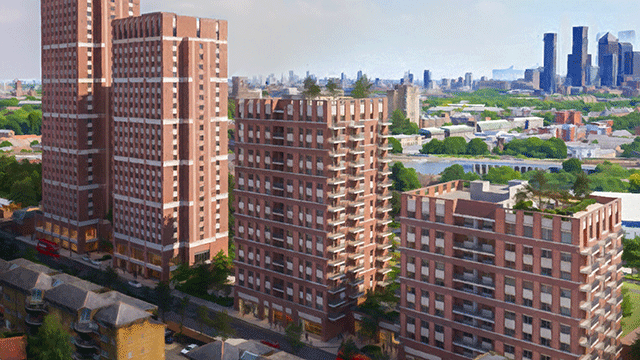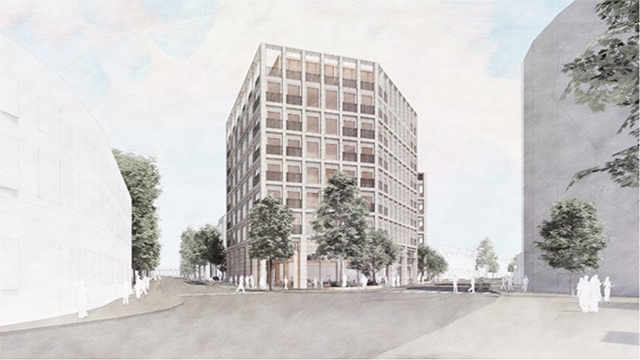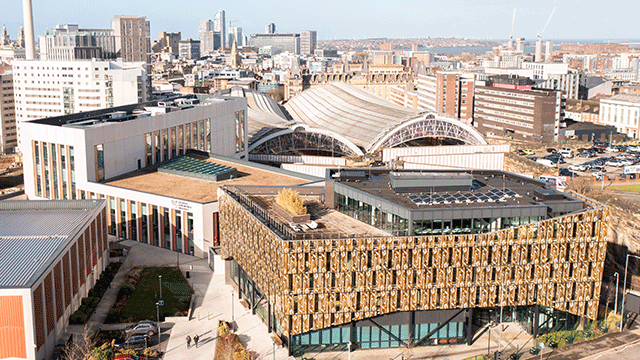There’s no doubt that the Brexit effect is suppressing demand and take-up in London’s office sector, but in fact the figures are not far behind long-term averages. Could a resolution to the EU question lead to a bounce-back in the capital?
London’s office market ended 2018 in comparatively good health, with availability rates contracting, grade-A rents stabilising or trending upwards, and market activity showing that occupiers and investors were exhibiting a good amount of faith in London’s long-term prospects.
Three months into 2019, we ask: How has activity so far this year manifested itself in the light of even more political uncertainty? How do we see the rest of the year shaping up? And who has claimed top spot in the first-quarter league tables?
Radius Data Exchange figures indicate that London office take-up reached just less than 2.6m sq ft in the opening three months of the year – representing a decrease of 33% on Q4 2018, and a 3% drop compared with the first quarter of last year. This total reflects a 21% decrease on the five-year quarterly average; and a 13% drop on the 10-year average for total space let.
The opening three months of the year are typically quiet for take-up, however. So, for opening quarterly periods only, the figures show a drop of 8% on the five-year average; and a 1% decrease on the 10-year-average, respectively.
The continuing furore surrounding Brexit as a singular explanation for these volumes being below long-term averages is slightly reductive, but it is inarguable that significant location-based decisions are being deferred until businesses can be confident in what the future operational realities will be for the country as a whole.
Clarity on that was meant to have come, in part, at the end of March. This would have allowed businesses more opportunity to plan for likely future trading relationships during the “transition period”, and enacting or finalising their space requirements accordingly. However, the fact that there remains no parliamentary approval for an agreed withdrawal leaves the default “no deal” position on the table – which is something businesses still have to legislate for.
The deferment of leasing decisions has been one consequence of this political stalemate – but exactly how long those deferments can continue will have a significant bearing on occupational performance for the rest of this year. Occupiers will have to balance any concerns about leaving themselves over-committed in London (if there is a subsequent requirement to move some operations to the continent) with the possibility of missing out on their preferred locations as a result of having to “wait and see” for a little longer than planned.
So, in light of the circumstances, and without a large-scale letting to help boost volumes (as in the second and third quarters of 2018) a lukewarm quarter was always likely for London. As ever, though, figures for some individual pockets of the capital gave reason for cheer.
The City fringe, West End and Midtown submarkets saw increases on Q1 2018 to the tune of 52%, 6%, and 61% respectively; while Docklands was the only submarket to see an increase in take-up against Q4 2018 – with more than double the amount of space let this quarter compared with last.
Anchor orders
Docklands’ quarter-on-quarter surge was anchored by the 72,200 sq ft letting to serviced office provider Spaces at 25 Cabot Square, E14; while Midtown’s 61% increase on the same period last year was helped by the largest individual letting this quarter – a 133,000 sq ft deal for Sony Music Entertainment at Handyside Street, N1.
Those two deals allowed technology, media and telecommunications firms and serviced office operators to take the top two positions for take-up by sector this quarter – commanding 19% and 14% respectively.
Philip Pearce, executive director for central London at Savills, indicates that serviced office operators are adapting their space requirements in light of changing attitudes from landlords.
“Serviced office providers are increasingly being pushed away from grade-A space because there is enough demand, so landlords don’t need to contemplate dealing with them,” he says. “Their unit size has dropped off and they are being forced more into 15,000-20,000 sq ft deals, but are doing more of them.”
Finance accounted for 13% of leasing activity in Q1. This is commensurate with previous quarterly totals, but is still an indication that the sector has, over the recent medium term, seen waning influence on new take-up as the drag factor of Brexit-based uncertainty continues.
Only once in the past four quarterly periods has the financial sector commanded more than 15% of take-up. When you consider that the typical share in the 10 quarters leading up to the EU referendum was consistently above this level (even during periods of aggressive expansion by tech firms across the capital), it underlines the concerns that financial businesses have clearly felt since 2016 when looking at their office footprint in London.
If there is a timely and satisfactory resolution of the Brexit impasse that enables firms to progress their location decisions, there is a healthy level of new-build space on offer to occupiers. Radius Data Exchange figures show around 15m sq ft of office space is currently under construction across the capital – 56% of which is without a tenant.
Just over 1.2m sq ft of that total is attributable to development starts in the opening quarter of this year alone – slightly ahead of the long-term quarterly average, and adding to the 1.8m sq ft that started in Q4 2018.
Anchoring that volume of Q1 construction starts was 8 Bishopsgate, EC1, which is a fully speculative project (at the time of writing) in the heart of the City of London – a submarket which is historically dependent on financial businesses. The fact that this project has got under way in light of all the uncertainty shows a level of confidence from the developer, Mitsubishi Estates, in London’s capacity to provide a basis for businesses to thrive, no matter what Brexit outcome comes to pass.
Other developers, however, have been noticeably reluctant to forge ahead on new development projects without a prelet. Just over 20m sq ft of office space across London sits at the “permission” stage – one-third of which is in the City core submarket. Balancing the provision of quality new space against the risk of flooding the supply-side market at an inopportune time mirrors the occupier quandary described earlier: act now, and risk exposure; or wait for the storm to pass, and risk missing out if demand levels do not meet expectations once projects begin in earnest.
Supply rates currently sit at 6.94% across the capital – an outward movement of 0.15 percentage points against last quarter, with only the West End submarket showing a contraction against Q4 2018. This is to be expected with a relatively quiet period on the lettings side, and still reflects a supply rate lower than we saw for seven consecutive quarters from Q1 2017.
Active availability footprint against overall stock is only one way of gauging levels of scarcity (looking at active demand through requirements would be another) – but it reflects sentiment of both landlords and occupiers simultaneously. Developers and landlords wouldn’t want this rate to jar too far upwards, risking oversupply and rents softening as too much choice floods the market; while occupiers saw during 2014 and 2015 the impact of acute and increasing scarcity – forcing higher rents across all grades of space.
Maxwell Shand, co-founder of Yard Nine, explains: “The supply dynamic has helped developers’ confidence, but those with secondary stock are finding it quite hard work getting leasing deals done. There’s quite a big deviation between the high-quality prelettable space and the secondary churn.
“Where either a developer or investor can get some space back into the market quite quickly they are trying to take advantage of this perceived lack of supply.”
At present, the maintenance of supply equilibrium over the past three months has contributed to the fact that grade-A rents have not seen a great deal of movement since the end of last year, according to our panel of agency experts. An average uplift across London of just 0.2% is a slower rate of growth than last quarter’s 0.3% bump against Q3 2018.
So, with take-up slightly below long-term figures, rents not appearing to move too much and supply rates staying relatively constant, it might not be too much of a surprise to see investment levels mirroring the environment of tranquillity, appearing shallow in the opening quarter on face value.
Completed transactions during Q1 totalled just shy of £1.4bn – representing a significant drop on last quarter, and against the opening three months of 2018.
However, there are a number of deals which exchanged in Q1 not included in this figure – most notably the £1.1bn transaction at 25 Canada Square, E14, which will probably be included in next quarter’s stats, and will help boost H1 investment volumes to a level commensurate with what we saw in the first half of 2018.
The Brexit process could continue to change the investment dynamic in the London office market, according to Tyler Goodwin, founder and chief executive at Seaforth Land.
“If Brexit continues for a long period or moves into a hard Brexit scenario, I think we are much more likely to enter an opportunistic environment, which is not common in central London,” he says.
“There’s lots of capital circling but not much landing and it could decide to go to another city as there are easier places to invest in.”
Stephen Down, head of central London at Savills, explains how the Brexit machinations are likely to lead to a staccato delivery of new assets to market.
“We have had an amazingly long run of activity since 2010 and now we are running out of stock to sell because it has been bought and stabilised, and people are quite happy to hold on,” he says.
“This medium-term extension [to Brexit] means we will probably get another hiatus in the run-up to October – I think the delivery of stock into the marketplace will be quite bumpy this year.”
The fact that development opportunities appear to be garnering interest from buyers is notable in light of the discussion around what occupiers want – focusing more on people-centric themes as well as optimisation of tasks linked to connectivity.
“A lot of the very visible deals in Q1 were on the development side of things,” Down says. “There was frenzied bidding on BT, which saw some of UK REITs return to have a go.”
Perhaps investors are spotting that they can get ahead of long-term challenges in the office sector by creating environments that are instantly fit for purpose in the digital age; and can future-proof their returns by ensuring that these new buildings are adaptable and accommodating to maturing occupier demands.
Main image © Mint Images/Shutterstock
Q1 league tables
City core
CBRE won the City core leasing league table for the second consecutive quarter, acting on more than 320,000 sq ft of landlord space to secure a 36% market share. Together with second-placed JLL, it brokered the 71,000 sq ft letting at 100 Liverpool Street, EC2, to Milbank, Tweed, Hadley & McCloy; as well as acting with ninth-placed Spring4 on the 50,000 sq ft deal for WeWork at 2 Minster Court, EC3.
JLL’s 30% market share was achieved through letting nearly 266,000 sq ft across 21 individual deals – making it the busiest agent in the City in Q1 by deals volume.
The largest deal in the City this quarter was the 82,500 sq ft sublease to Bulb at 155 Bishopsgate, EC2, which enabled landlord agent BH2 to take fifth place in the standings.
City fringe
A seventh quarterly win in a row for Colliers International in the City fringe, as it acted on disposals spanning nearly 99,000 sq ft to help secure a 30% market share. It was also the most active agent in the submarket by deals volume – with 20 individual lettings contributing to its overall success.
Colliers’ largest individual deal was at Petersham House, EC1, in a 15,000 sq ft letting to WSC. JLL’s second-place finish was anchored by acting on the two largest transactions in the City fringe this quarter: namely, a 29,300 sq ft letting to Tech Hub at Fitzroy House, EC2, and a 28,800 sq ft deal for the Open Society Foundation at Herbal House, EC1.
Anton Page’s strong deals volume helped propel it to third place this quarter, up from fourth position last time out.
Docklands
A joint victory between three agents in the Docklands submarket, with Knight Frank, CBRE and Squarebrook sharing top spot this quarter.
All three of those agents acted on deals at 25 Cabot Square, E14, measuring 72,200 sq ft to Spaces; and 21,549 sq ft to the Office of Rail Regulation respectively.
Midtown
The first change-of-hands at the top of a submarket league table this quarter, as Cushman & Wakefield toppled Q4 victor CBRE to take the Q1 crown by acting on more than 160,000 sq ft of landlord space to secure a 43% market share.
The largest deal of the quarter in the whole of London – a 133,000 sq ft letting to Sony Music Entertainment at Handyside Street, N1, was critical to achieving this – Cushman acted alongside second-placed Savills on that deal; as well as 11,300 sq ft to Macfarlanes at 20 Furnival Street, EC4.
Bluebook sprang into the top five in Q1 from 17th place in last quarter’s league table, securing a 12% market share in the process of letting nearly 45,000 sq ft – helped by its joint-disposal with CBRE of 23,000 sq ft at 1 New Oxford Street, WC1.
Southern fringe
BNP Paribas Real Estate climbed to the top of the table in the Southern fringe this quarter, having finished in fifth position last time out. It advised on just over 42,000 sq ft of landlord space to secure a 35.5% market share.
The company acted on the largest individual deal in a quiet submarket this quarter, disposing of 30,000 sq ft to The Challenge at Elizabeth House, SE1.
West End
The West End was another submarket in which the winners from the final quarter of 2018 retained their position at the top, as CBRE brokered almost 292,000 sq ft across 18 deals to secure a 43% market share.
CBRE acted on the two largest transactions in the West End this quarter – namely, 54,000 sq ft to Glencore at 18 Hanover Square, W1, and 52,000 sq ft at 21 Dartmouth Street, SW1.
Tuckerman also acted on that Dartmouth Street transaction, helping it to climb from ninth place last quarter into the top five this time around. Colliers International also rose impressively – up to third place this quarter after finishing 15th in Q4. Colliers’ success was helped by a 51,300 sq ft letting to Cinven Partners at 21-21 St James’s Square, SW1, which it let alongside Savills.
Overall leasing
CBRE acted on more than 770,000 sq ft of landlord space across the first three months of 2019 to hold on to the quarterly crown it claimed last time out – mirroring a trend across the submarkets.
Runner-up JLL acted on just under 435,000 sq ft to secure a 16% market share, and edge Cushman & Wakefield, which disposed of nearly 420,000 sq ft of landlord space across 29 individual transactions, into third place.
CBRE acted on four of the largest seven deals across the quarter – several of which are referenced in submarket table descriptions. It brokered 45 deals – a total bettered only by sixth‑placed Colliers International, which acted on 48.
Squarebrook and Allsop jumped into the top 10, from 34th and 13th place respectively – boosted in Squarebrook’s case by letting activity at Cabot Square, E14, and for Allsop by a 32,100 sq ft deal for WeWork at Dixon House, EC3.
Q1 investment
In one of the most democratised investment league tables on record, Michael Elliott took the title, having advised on a total of £376m in Q1. This was enough to propel it up to top spot from eighth place last quarter, representing a 14% market share.
A big part of this was the deal for around £100m at 169 Union Street, SE1, on which it advised purchaser Brockton Capital; and the acquisition of the Steward Building, E1, for £97m in January.
Hot on its heels were Savills and Cushman & Wakefield, which advised on £363.5m and £347.2m respectively to complete the podium finishers in what was, overall, a subdued quarter for office investment in London.
To send feedback, e-mail graham.shone@egi.co.uk or tweet @GShoneEG or @estatesgazette











